Browse Houses
Search Results: Returned 5927 records. Displaying results 401 – 500
| House name | Description | |
|---|---|---|
| Ballyara or Ballyhara | The original Ballyara Castle was formerly associated with the O'Hara family. At the time of Griffith's Valuation, Patrick Mullarkey was leasing a building valued at £3 at Ballyara, barony of Leyny, from the Ffolliott estate. | |
| Ballyard | The representatives of Peter Foley were leasing a property at Ballyard to Margaret Crosbie at the time of Griffith's Valuation, when it was valued at £30. Lewis records Ballard as the seat of Francis Crosbie in 1837. | |
| Ballyard (Thompson) | At the time of Griffith's Valuation, Robert Thompson was leasing a property at Ballyard, to Henry Stokes, when it was valued at £20. Bary records that Henry Stokes was the County Surveyor of Kerry in the mid-nineteenth century and lived in Tralee at that time. He was married to Letitia Bland and they later moved to south Kerry to lands owned by the Bland family. | |
| Ballyard B | Geoffrey Eager was leasing a property to Patrick Ryan at the time of Griffith's Valuation, when it was valued at £15. | |
| Ballyard House | At the time of Griffith's Valuation, Francis Crosbie was leasing Ballyard House from Reverend Arthur Rowan, when it was valued at £35. The Colthurst Estate sale notice of 1856 notes that Thompson leased the property from Nicholas Colthurst in the 1820s and that A.B. Rowan was an assignee of Thompson. Bary states that this house was possibly re-modelled by Peter Thompson in the late 1820s. |

|
| Ballyargadaun | In 1906 Charles O'Farrell was the owner of a house valued at £4 at Ballyargadaun, barony of Leitrim, county Galway. This may be the gatelodge at the entrance to the Dalystown demesne or may be buildings associated with the plant nursery in the same townland. {Grid Reference is for gate lodge] | |
| Ballyarr House | Lord George Hill was leasing this property from Mrs. Brooke at the time of Griffith’s Valuation, when it was valued at £35. He resided there until his death in 1879. Ballyarr is still extant. | |
| Ballyartney | A house built by the Quaker family Barclay in the 18th century and their home in the 18th and 19th centuries. In 1786 Wilson mentions Ballyartney as the seat of Mr. Barclay. The house was occupied by Charlotte Barclay at the time of Griffith's Valuation but she held it from the Court of Chancery. Home of the O'Dea family in the 20th century. Unoccupied in 2009. |
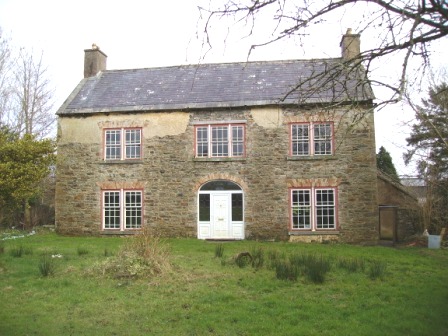
|
| Ballybanagher | A Nolan family home, now a ruin. It was held in fee by Andrew Nolan at the time of Griffith's Valuation when it was valued at £12. In 1894 Slater recorded it as the seat of Christopher R. Browne. |

|
| Ballybane | [Leet records George Gaggin of Ballybawn, Buttevant, county Cork in 1814.] Ballybane was occupied by T. Gaggin in 1837 and by William Gaggin in the early 1850s. The house was valued at £22 and held from Laurence Corban. This house was recently renovated. |
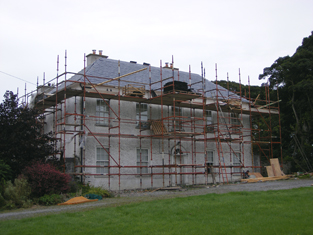
|
| Ballybaun | At the time of Griffith's Valuation, Lord Clonbrock owned a mill, gate house and other buildings valued at £35 in the townland of Ballybaun, parish of Ahascragh. The gate house is still extant and occupied. Local sources suggest it was at one time used as a school for children in the area. |
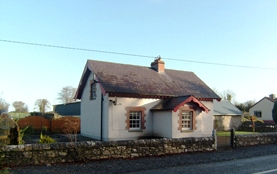
|
| Ballybaun | Wilson refers to Ballybawne as the seat of Mr. Kelly in 1786. Occupied by John Kelly in 1837 and by John Mahon at the time of Griffith's Valuation. The sales rental of 1863 includes a lithograph of Ballybaun, which was described as 4 storeys high. The house was occupied by the Mahon family until 1916 when it was taken over by the Congested Districts' Board. It is no longer extant. |
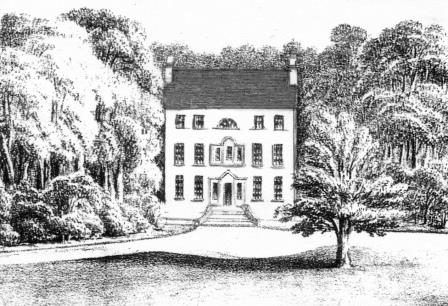
|
| Ballybaun | Valued at £12.10 shillings at the time of Griffith's Valuation and occupied by Patrick Cahir senior, who held it from Francis Fitzgerald. It is labelled Ballybaun House on all of the Ordnance Survey maps. A house is still extant at the site. | |
| Ballybay House | Ballybay House, also known as The Castle, was the home of the Leslie family, designed by John Keane and built in 1830. It was located a short distance from the town. It was described by Lewis in the 1830s as a ‘handsome and beautiful mansion situated on the border of a lake and backed by some extensive plantations’. In the mid-19th century its rateable valuation was £120 and it was the home of Emily Leslie. It later became the home of Edward John Henry Leslie (1890-1966), British Ambassador to Rome. The house was burnt down in 1921. The walled garden and some outbuildings remain. | |
| Ballybay House | Ballybay House, also known as The Castle, was the home of the Leslie family, designed by John Keane and built in 1830. It was located a short distance from the town. It was described by Lewis in the 1830s as a ‘handsome and beautiful mansion situated on the border of a lake and backed by some extensive plantations’. In the mid-19th century its rateable valuation was £120 and it was the home of Emily Leslie. By 1906 this valuation had risen to £140. It later became the home of Edward John Henry Leslie (1890-1966), British Ambassador to Rome. The house was burnt down in 1921. The walled garden and some outbuildings remain. | |
| Ballybeg | At the time of Griffith’s Valuation, Michael Galway was leasing a house valued at almost £6 at Ballybeg to Michael Manning. Leet records Mat. Moriarty as the proprietor in 1814. Bary indicates that the house had disappeared by the end of the nineteenth century. | |
| Ballybeg (Mitchelstown) | In 1786 Wilson states that "Ballybeg, the seat of Mr. Spratt, was pleasantly situated at the foot of a lofty mountain" outside Mitchelstown. Local history suggests that this was a property acquired by Devereux Spratt in the 17th century. It is not named on the 1st edition Ordnance survey map though buildings are shown at the site. | |
| Ballyboe | A house valued at £17+ in the mid 19th century when it was occupied by James O'Donnell and held from Lord Lismore. This house is still a family residence. |

|
| Ballyboe House | This property was held in fee by the Bateson estate at the time of Griffiths Valuation in the 1850s when it was valued at £27. It is labelled Ballyboe House on the 25-inch Ordnance Survey map of the early 20th century. It is still extant. | |
| Ballyboy | The residence of John Travers in 1814, of R. Croker in 1837 and vacant in the early 1850s when it was held by James Fennessy from Viscount Lismore. A house and farm are still extant at the site. | |
| Ballybrack House | Hugh Henry was leasing this property from Gardiner Boggs at the time of Griffiths Valuation in the 1850s. It was valued at £21. The 1870 Landowners Survey notes it as the address of Tristram Cary. It is no longer extant. | |
| Ballybrada | The residence of Joseph William Fennell in 1814 and 1837. In 1840 the Ordnance Survey Name Books describe "Ballybrado House" as "old and plain, the residence of William Pnnyfeather". Thomas Fennell held the house and offices and 206 acres including a Quakers' graveyard from William Pennefather at the time of Griffith's Valuation. The buildings were valued at £21. The original house as marked on the first Ordnance Survey map is not extant now. The National Inventory of Architectural Heritage website features Ballybrada House built 1879, possibly by the Denny family. Charles E. Denny was resident in 1906 when the buildings were valued at £141+. |
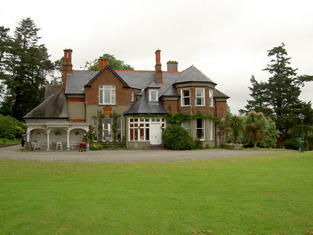
|
| Ballybricken House | Described by Lewis in 1837 as "the elegant mansion and demesne of D.Connor". It was held in fee by him at the time of Griffith's Valuation when it was valued at £64. The residence of Captain Denis Connor in 1894. In 1943 the Irish Tourist Association Survey mentions it as the residence of J.E. Bird, the walls built in 1820 but the interior having been restored following a fire in 1910. The Survey also notes that it was used as a base by the American navy during the first World War. The site is now covered by industrial premises. | |
| Ballybride | James O'Farrell was leasing over 180 acre and a herd's house from Louisa Pelly at Ballybride, barony of Roscommon, at the time of Griffith's Valuation. | |
| Ballybroder | In 1814 Ballybroder was the seat of Henry Burke. Ballybroder was recorded as the property of Mr. Burke in the 1830s. In 1855 Patrick Burke was leasing the house at Ballybroder from Peter Dolphin. In 1906 Eleanor M. Burke is recorded as the owner when the house was valued at £10. The house at Ballybroder is still extant and in reasonable repair but unoccupied. |

|
| Ballybrood | A house in the village of Ballybrood, the residence of a branch of the Maunsell family in the 18th and early 19th centuries. Occupied by Samuel Maunsell at the time of Griffith's Valuation and held by him in fee. The buildings were valued at £11+. | |
| Ballybroony | An 18th century house, occupied by Fallon in the late 1770s and in 1786. The residence of the Perkins family from the early 19th century. It was held by Arthur Perkins from the Earl of Arran at the time of Griffith's Valuation when it was valued at £17. Lived in until the early 21st century and for sale in 2006. Restoration work was underway in 2010. |

|
| Ballycahill | A house at Ballycahill valued at £11+ was occupied by Mrs Mary Cormack at the time of Griffith's Valuation and held from Doctor Wall. | |
| Ballycannan | A house held by James Gloster in fee at the time of Griffith's Valuation and valued at £20. This house is marked on the first Ordnance Survey map. | |
| Ballycannan | A house valued at £18.10 at the time of Griffith's Valuation and held by John Boyce from George Gloster. No large house marked in this townland at the time of the first Ordnance Survey. Demolished in 1963. |
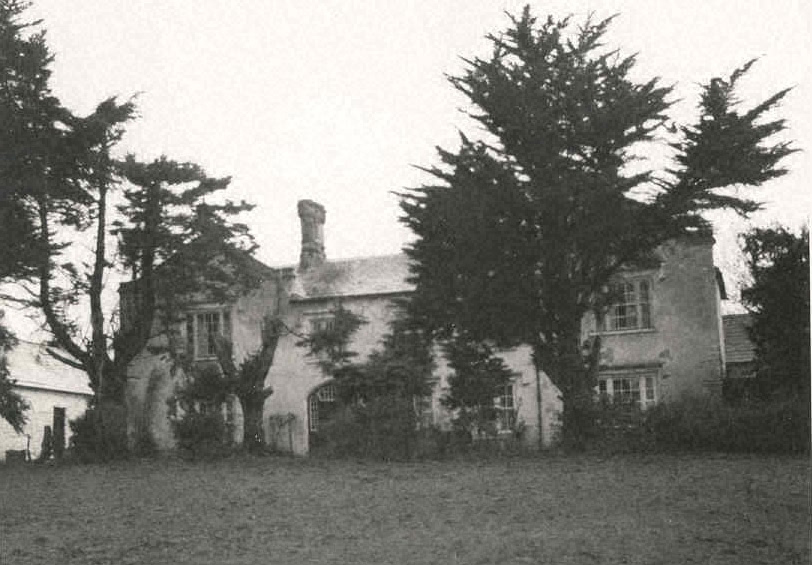
|
| Ballycannon | The home of the Spread family in the 18th century, by the time of Griffith's Valuation the buildings were valued at £7 and occupied by Michael and John Daly who held the property from the representatives of William Spread. A building is still extant at this location. | |
| Ballycanvan House | In 1848 George Kent was leasing this property from Eliza Bolton when it was valued at over £34. The demesne was included in the sale of Bolton property in June 1857. In 1814 Leet notes it as the seat of Samuel Roberts. The house was in ruins by the end of the twentieth century. | |
| Ballycar | Home of the Colpoys family in the 18th and early 19th centuries. Wilson refers to it as the seat of Mr. Colpoys in 1786. It passed by marriage to the O'Callaghan family. The sale rental of 1850 describes Ballycar as a cottage style residence with 'a fine garden attached'. By the time of Griffith's Valuation the house was occupied by Edward Bennett who held the property from the Misses Abbott. At this time it was valued at £18. A house is still extant at the site. | |
| Ballycar (Cove) | George Gibsen was leasing a property at Cove from John Purcell Fitzgerald in 1848 when it was valued at £15. This may be the house, built after the 1st Ordnance survey and labelled on the 25-inch map of the 1890s as Ballycar House. The property at the site is now used as offices. |
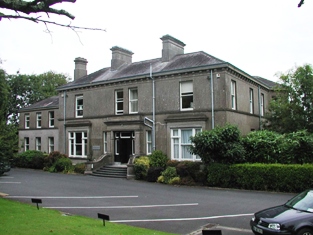
|
| Ballycarron | The Butlers are described as "of Ballycarron" from the early 18th century. Ballycarron was the residence of Thomas Butler in the 19th century, held from Michael Gavin in the 1850s when the buildings were valued at £36. ''Burke's Irish Family Records'' states that the proceeds of the sale of the Ballycarron estate and the house itself were bequeathed "to the Church". This building is now divided into residential apartments. | |
| Ballycarroon | A house dating from the early 19th century. At the time of Griffith's Valuation it was occupied by Isadore Andrew Lynch, who sub leased it from Henry Charlton. Later occupied by members of the Craven and Connor families. A house still exists at the site. | |
| Ballycarty House | At the time of Griffith's Valuation, Charles Blennerhassett was leasing this property to Rev. Edward Nash, when it was valued at £19 5s. Bary states that it was occupied by the Nash family from the late eighteenth century and that it was destroyed in 1922. In 1786 Wilson notes the existence of the ruins of Ballycarty Castle, the property of Mr. Nash. | |
| Ballycaseymore | An 18th century house close to the entrance to Shannon Airport, it was the home of the Miller/Riggs Miller family. From 1814 it appears to have been leased to the Canny family, John Canny was in residence then and Matthew Canny at the time of Griffith's Valuation. The property was inherited by Thomas John Ryan of Tyrone House, county Tipperary in the 1880s and was sold in 1913. It is now a craft and design centre. |
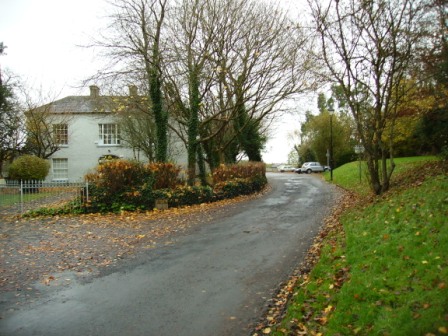
|
| Ballycasheen House | Henry Curtayne was leasing a property in the townland of Ballycasheen from Lord Kenmare’s estate at the time of Griffith’s Valuation, when it was valued at £18. Nearby in the same townland he also held Courteene Hall, which was vacant at the time and was valued at £10 10s. Leet records him as resident at Ballycasheen in 1814. Lewis referred to the residence of the Curtayne family as Courtayne Castle in 1837. The site of Ballycasheen House is now occupied by commercial buildings while The Heights hotel occupies the site of Courteene Hall. | |
| Ballycastle House | ||
| Ballycastle House | A house which appears to have been built after the publication of the 1st Ordnance Survey. It is labelled Ballycastle House on the 25-inch map of the 1890s. In 1894 Slater records it as the residence of Edmund Alexander Mullins. A house is still extant at the site. |

|
| Ballyclery | The house at Ballyclery is described as a caretaker's house for the St.George estate. It was valued at £8 in 1855. An occupied house still exists at this site but may have been modernised. | |
| Ballyclogh | A house on the Monteagle estate, leased to John Copley for ever. The house was 3 storeys high and had been repaired in 1810 by Copley. His representatives were subletting the house to Patrick Griffin by the time of Griffith's Valuation when the buildings were valued at £32. This house is now a ruin. |

|
| Ballyclogh | The home of a branch of the Morony family during the 19th century. Occupied by James Todd in the early 1850s who held the property valued at £38 from the Moronys. An occupied house is still located at this site. |

|
| Ballyclogh Castle | At the time of Griffith's Valuation Thomas Haines and Son owned a house, corn and flour mill and offices in the townland of Ballyclogh valued at £82. This property was held with 4 acres from the representatives of C.P. Coote and John Wrixon. In 1906 Ballyclogh was occupied by the representatives of Charles P. Coote. The house was located adjacent to a medieval tower house. Both the house and mill are now in ruins. | |
| Ballyclogh House | The Ordnance Survey Field Name Book refers to the building of this house in 1822 by Henry Rose as a cost of £600. Occupied by P. Cudmore in the 1830s and by Henry Rose at the time of Griffith's Valuation who held the property from the representatives of Samuel Dixon [Dickson]. The buildings were valued at £9+ in the 1850s. Ballyclogh is still extant. |

|
| Ballyclogh Lodge | Ballyclogh House and Lodge are both marked on the first Ordnance Survey map of county Limerick. At the time of Griffith's Valuation John Russell held land in the townland with associated buildings valued at £12 from Michael Furnell. There were also mills in the townland valued at £35. Valued at £10+ in 1906 when occupied by George Furnell, Ballyclogh remained in the possession of the Furnell family until 1973. | |
| Ballyclogh [Ballyclough] | This property was inherited by the Barrys through marriage with a member of the Purdon family. Parts of this house may have dated from the 17th century. Lewis writes of "a handsome mansion in the Elizabethan style". Additions were made in the 19th century. At the time of Griffith's Valuation it was valued at £34 and held by James Barry in fee. The house was burnt in the 1920s. The north wing survived, built 1904. In 1944 the Irish Tourist Association survey noted that Ballyclough was the birthplace of Sir Redmond Barry, "prominent in public life in the state of Victoria, Australia". It was restored and is still a residence. |
![Photo of Ballyclogh [Ballyclough]](https://landedestates.ie/storage/img/orig/1568.jpg)
|
| Ballyclohy | Leased from the Disney estate by James Moloney in 1850, when it was valued at £11 10s. | |
| Ballyconnell (Kilmacrenan) | Ballyconnell House was held in fee by Wybrant Olpherts at the time of Griffith’s Valuation, when it was valued at £45. It was reputedly built by the Olpherts family in the 18th century. In 1837 Lewis noted it as the seat of Rev. J. Olphert. In 1906 it was the property of Sir John Olphert and valued at almost £46. Ballyconnell is still extant. It served as a school during the 20th century. Local sources suggest it was later purchased by Udaras na Gaeltachta. |

|
| Ballyconnell Castle/House | Ballyconnell Castle was built in 1764 by George Leslie Montgomery to replace a former early 18th century building which was accidently burnt down. Leet records Mrs Storey as resident in 1814 and Lewis records John Enery as the occupier of Ballyconnell House in the 1830s. The Enerys and Montgomerys were related. In the mid-19th century George Roe, a medical doctor, was the owner and occupier, having purchased the property valued at £40 for rates, from the Enerys, when it was described as a ‘spacious and comfortable mansion, with suitable out-offices’. In 1906, Samuel B. Roe was recorded as the occupier when the buildings were valued at £32.10.0. for rates. It is now located in the middle of a housing estate. |

|
| Ballyconnoe House | A summer home of the Creagh family, also known as Prospect Lodge. It was valued at £8 at the time of Griffith's Valuation when Cornelius Creagh held the house and townland in fee. Weir writes that an earlier house was in ruins in 1842, see M169 007, townland of Ballyconnoe North. It is no longer extant and a modern house has been built nearby. | |
| Ballyconry House | Eyre Stack was in possession of Ballyconry House at the time of Griffith's Valuation, when it was valued at £13. In 1814 Leet noted Ballyconry as the residence of John Stack while Lewis mentions it as the seat of Eyre W. Stack in 1837. Bary writes that it later came into the ownership of the Rice family, became semi-derelict but was then rescued and used a Youth Centre. She notes that it was also known as Ballyloughrane House. | |
| Ballycorban | In 1856 Matthew White was leasing a house valued at £10 at Ballycorban, in the parish of Ballynakill, barony of Leitrim, county Galway from the Burke of Marble Hill estate. Ballycorban is still extant and occupied. |

|
| Ballycrenode House | In 1840 the Ordnance Survey Name Books refer to the site of Ballycrenode House in the parish of Kilkeary, stating "only those people who are very old can recollect seeing any part of this house standing". This original Ballycrenode House belonged to the O'Carroll family and the last inhabitant was a Major O'Carroll. The site is marked on the 1st edition Ordnance Survey Map. At that time and in Griffith's Valuation, the townland belonged to the Toler estate. The 25-inch map of the 1890s shows a later Ballycrenode House, located slightly to the north-west of the original site. This property is still extant, part of a large farm. | |
| Ballycuggaran | Weir writes that the present house dates from the late 19th century. An earlier building was in the possession of members of the Church of Ireland episcopacy. Occupied by Marcus Patterson in the mid 19th century and held by him in fee. The buildings were valued at £8. In 1906 Marcus Wyndham Patterson owned Ballycuggaran with 618 acres of untenanted land. [Grid reference is approximate]. | |
| Ballycullen House | This house was built in 1740 by Carrol Naish on the foundation of Ballycullen Castle according to the Ordnance Survey Name Book. Occupied by Patrick C. Nash in 1814 and by Carroll Nash at the time of Griffith's Valuation, it was held from Henry Hare and valued at £14. It is still extant and was restored during the twentieth century. | |
| Ballycummin | Roche Castle was a residence of Sir David Roche at the time of Griffith's Valuation held from the Bishop of Limerick and valued at £30. | |
| Ballycummin | A house valued at £8 when occupied by Roderick J. Hanley, who held it from Laurence Murray, at the time of Griffith's Valuation. Described by Lewis in 1837 as the former seat of the Earl of Roscommon and at that time occupied by Lieutenant Rodrick J. Hanly. | |
| Ballycunneen | Hogan writes that this house was built in 1805 by Thady, son of Thady O'Halloran the diarist, in front of the old Hickey house. Marked on the first Ordnance Survey map this house was occupied by Stephen O'Halloran who held the property from Colonel George Wyndham. It was valued at £15 and had 159 acre demesne. The house is still extant. | |
| Ballycurkeen | The home of James Manderville in the mid 19th century, held from James F. O'Ryan and valued at £19+. Ballycurkeen was still a Mandeville home in the early 1940s when Frank Mandeville was recorded as resident. The Irish Tourist Association surveyor also writes that Ballycurkeen was the residence of John O'Mahony, a Fenian leader in 1848. This house is still a family home. |

|
| Ballycurrany House | This house was occupied by Joseph Wilson at the time of Griffith's Valuation. He held it from James H. Smith Barry and it was valued at £13. It is no longer extant. | |
| Ballycurrin | A house built in 1828 on the shore of Lough Corrib to replace an older one. Wilson refers to the latter as the seat of Henry Lynch in 1786. Held in fee by Charles Lynch at the time of Griffith's Valuation, when it was valued at £18 10s. Slater recorded it as the seat of Charles Lynch in 1894. It was burnt in 1921. In 2007 this house was being renovated and offered for sale. |

|
| Ballydangan | At the time of Griffith's Valuation James Thorngate was leasing a property valued at £6 at Ballydangan, barony of Moycarn, to James Miller. There is no house marked on 1st edition OS map at this location, though a police barracks is shown nearby. The building is no longer extant. | |
| Ballydavid | The residence of Marcus C. Russell in 1814 and of John Russell at the time of Griffith's Valuation, when it was valued at £26.15 shillings and held from Edward H. Byrne. The sale rental of 1854 includes a lithograph of this house. It was bought by Richard Power and his descendants continued to live in the house until 1950. The house was demolished in 1963. | |
| Ballydavid | In the mid 19th century Patrick Murphy held a house valued at £10 from Thomas Power in the townland of Ballydavid. | |
| Ballydavid | G. Baker was resident at Ballydavid in 1837 and in the early 1850s when the house was valued at £13.10 shillings and held from the Reverend George Cole Baker. In 1786 Wilson refers to Ballydavid as the seat of Mr. Baker. In 1840 the Ordnance Survey Name Books had noted that the house was in bad repair though the demesne was described as "neatly ornamented". This house no longer exists. | |
| Ballydavid House | Ballydavid House, Passage East, is given as the address of William Armstrong, JP, in the 1870s. At the time of Griffith's Valuation, this house was held in fee by Francis O'Beirne and valued at over £50. In 1814 Leet refers to Balydavid as the seat of Michael Kennedy. The 1945 ITA survey noted it as the residence of Lady Armstrong but formerly associated with the Armstrong and Paul families. There is still an extant house at the site. | |
| Ballydehob Cottage | At the time of Griffith's Valuation, Patience Noble was leasing this property to William J. Swanton, when it was valued at £8 10s. In 1906 it was owned by Robert Swanton and valued at £10 10s. | |
| Ballydine | The Mandevilles were situated at Ballydine from the 14th century. Ballydine Castle was sold to the Earl of Clonmel in 1781 and members of the Power family lived there in the first half of the 19th century, William Power in 1814 and James Power in the early 1850s. The Powers and the Mandevilles were related. A lithograph of the house is included in the Power sale rental of 4 November 1853. ''Burke's Irish Family Records'' records Frank Hackett Mandeville (1841-1905) as the last family member to live at Ballydine. He was Member of Parliament for mid Tipperary 1892-1900 and died at Ballydine Castle in 1905. Mary Lyons records the Landy family as resident from 1855-1901. | |
| Ballydivlin House | Rev. John Foley was leasing this property from Lionel Fleming at the time of Griffith's Valuation, when it was valued at £10. Lewis recorded it as the seat of Lionel J. Fleming in 1837. Family history sources suggest it was usually given to the second son of the New Court family. Builidngs are still extant at the site. | |
| Ballydonagh | Lewis records Ballydonagh as the seat of F. Madden in 1837. At the time of Griffith's Valuation the house was occupied by Francis Madden leasing from the Haughton estate and was valued at almost £4. Substantial ruins still remain at this site. | |
| Ballydonagh House | Described as a steward's house at the time of Griffith's Valuation, when it was held in fee by Maria Fitzpatrick and valued at £13 9s. Labelled Ballydonagh House on the 25-inch edition of the Ordnance Survey in the 1890s. | |
| Ballydonnellan Castle | At the time of Griffith's Valuation, Ballydonnellan Castle was occupied by John D. Mahon and was valued at £62. It was still extant in the 1890s but is described as "in ruins" on the 1933 edition of 6" map. These ruins are still visible. |

|
| Ballydonohoe | A property held by a junior branch of the Fitzgerald family. The house was the residence of John Church in 1814, Thomas Fitzgerald in 1837 and of St John Thomas Blacker in the early 1850s. It was valued at £13 at that time. |
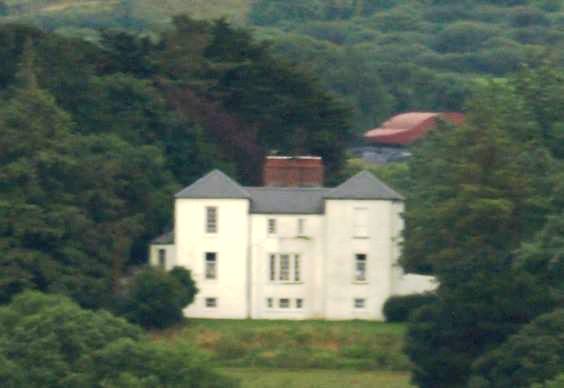
|
| Ballydowny | Bary states that "Ballydowney is a very old house, probably built in the early 18th century. It was the house in which Robert Emmet, the patriot hanged in Dublin in 1803, was born. His mother was Elizabeth Mason". The Ordnance Survey Name Books record that the proprietor, St. John Mason, had leased the townland to Richard McGillycuddy in the 1830s. By the time of Griffith’s Valuation, the house was valued at £4 and being leased by Charles Daly from Daniel Cronin. In the early 1940s, the Irish Tourist Association Survey also refers to the possible association with Robert Emmet though it indicates that this story may refer to an earlier house, "replaced by the present one, built about a hundred years ago". In 1942 it was occupied by a Mr. Blanchfield and is still extant. | |
| Ballydrehid | In 1786 Wilson refers to Ballydrehid as a seat of Viscount Lismore, "pleasantly situated on rising ground". The home of Robert Keating in 1814 and of Robert Doherty in the early 1850s. Doherty held the property from Viscount Lismore and the house was valued at £17. This house is still extant and occupied. |

|
| Ballyduff | Ballyduff was the residence of Hunte Esq in the 1770s. In 1814 J. Minchin occupied Ballyduff, Thurles. In the mid 19th century Benjamin White of Ballyduff held the house valued at £11 and 48 acres from John Hunt. The Hunts and Whites were related. Ballyduff , the estate of John Hunt, was advertised for sale in December 1859 and again in November 1860. The house marked on the 25'' OS map is not on the same site as the original house marked on the first edition OS map. Henry O'Neill of Shanballyduff, Thurles, held 155 acres in the 1870s. The will of Henry O'Neill of Annesbrook, county Dublin and Ballyduff, county Tipperary dated 2 Oct 1891 is in the National Archives (T.12,231). Some of his descendants live in Argentina, see http://www.irishgenealogy.com.ar/genealogia/N/ONeill/henry.htm | |
| Ballyduff Castle Farm | Described as Ballyduff Castle (in ruins) on the 1st edition Ordnance Survey map, these buildings were valued at £11 15s at the time of Griffith's Valuation. They were being leased by Edward Walsh from the Musgrave estate. The National Inventory of Architectural Heritage suggests the house was built c.1825. The ruined fortified house at the site dates from the early seventeenth century. |
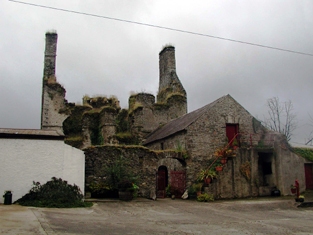
|
| Ballyduff Glebe | Reverend John Bourke was leasing this property from Viscount Doneraile at the time of Griffith's Valuation, when it was valued at £13 10s. It continued to serve as the Rectory for the parish and there is still a house at the site. | |
| Ballyduff House | David La Touche was leasing a property valued at £8 to John A. La Touche, at Tomloskan, barony of Carrigallen, at the time of Griffith's Valuation. The house is not marked on the First ed. Ordnance Survey map but does appear on the later 25-inch series. This house is still extant and has been restored. | |
| Ballyduff House (Kilmeadan) | In October 1851, the sale notice for Henry Langley's property at Kilmeadan noted that the demesne at Ballyduff was well planted and the house at a little cost could be put into excellent order. The tenant at the time was John Sadlier, MP. At the time of Griffith's Valuation it had been occupied by John William Langley leasing from Henry Langley and was valued at £9. There is still an occupied house at Ballyduff. | |
| Ballyduff House (Raphoe North) | At the time of Griffiths Valuation, William Clarke was leasing this property from the Knox estate when it was valued at £17. It is still extant and occupied. |
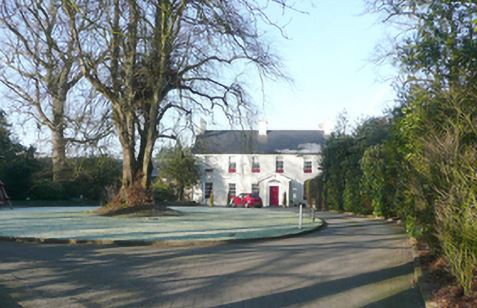
|
| Ballyduffbeg | James Lynch was leasing this property from the Devonshire estate at the time of Griffith's Valuation, when it was valued at £10. | |
| Ballyduffmore | Eleanor Walsh was leasing this property from the O'Dell estate at the time of Griffith's Valuation. Ballyduffmore is still extant and occupied. |

|
| Ballydugan | In 1786 Wilson refers to Ballydugan as the seat of William Burke. Rev. Michael Burke was the owner of Ballydugan at the time of Griffith's Valuation, when it was valued at £24. In 1906 Michael H. Burke owned the mansion house at Ballydoogan then valued at almost £27. It was burnt in 1922 but rebuilt, with modifications, in 1929. Much of the family and estate archives were destroyed in the fire of 1922. Ballydugan is still extant and occupied. |
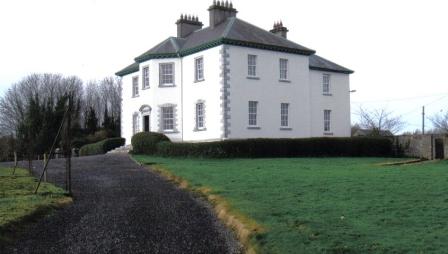
|
| Ballydulea | A house occupied by Edmond Bourke in the mid 19th century, held from Anne Payne, Mrs Cummins and the Reverend Fleming and valued at £14.10 shillings. In 1896 the encumbrances on land at Ballydulea was being finalised. The vendor was the Reverend Joseph King Cummin, see The Irish Law Times and Solicitors' Journal Vol XXX (1896). |
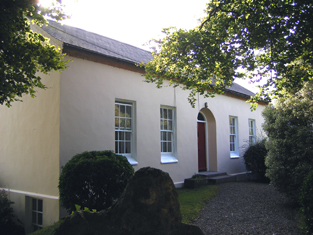
|
| Ballydurn | Ballydurn was leased by George Moore from the Beresford estate in 1850 when it was valued at £10. An extensive farm exists at this site. [Grid Reference is approximate] | |
| Ballyduvane | Edward Herrick was leasing this property from Mrs. Eliza Beecher at the time of Griffith's Valuation, when it was valued at £12 5s. Lewis refers to it as the seat of E, Herrick in 1837. In 1814 Leet noted it as the residence of Thomas Herrick. Referred to by Slater as the seat of M.A.R. Beecher in 1894. There is still a house at the site. | |
| Ballyduvane House | Ballyduvane House was held in fee by Mrs. Eliza Beecher at the time of Griffith's Valuation, when it was valued at £25 10s. Lewis refers to it as the seat of M. Becher in 1837. There is still an extant house at the site. | |
| Ballyeagh House | Sophia Herranc held this property in fee at the time of Griffith's Valuation, when it was valued at £3 10s and part of a holding of 540 acres. It is described as a Steward's House. This appears to be Ballyeagh House, built after the 1st Ordnance Survey map was published and labelled as such on the later 25-inch map of the 1890s. Now the site of a large farm. | |
| Ballyedekin | A house valued at £20 at the time of Griffith's Valuation, occupied by John Leech and held from the representatives of Viscount Midleton. Buildings are still extant at this site. | |
| Ballyedmond | Ballyedmond passed through marriage from the Brownes to the Courtenays. Robert Courtney was the proprietor of Ballyedmund in 1814. John Courtenay held Ballyedmond from the Reverend William Halloran in the mid 19th century. The buildings were valued at £199. The seat of Robert Courtney Smith-Barry in 1894. Inherited by the Smith Barrys and sold by them in the 1960s. The house no longer exists but much estate architecture including gate lodges survives. |
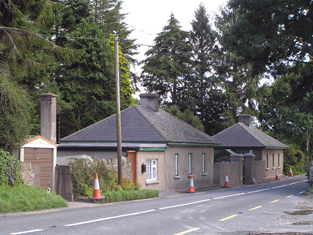
|
| Ballyegan | At the time of Griffith's Valuation, Richard Norris was leasing this property to John Millward (senior), when it was valued at £6. In 1814 Leet noted John Hartnett as resident at Ballyegan. Bary indicates that the Millwards occupied this property until well into the twentieth century though they moved to a different house. The original house was demolished to make way for a quarry. | |
| Ballyeighter | In 1814 Ballyeighter was the residence of Anthony Donnellan. Lewis records Balleighter as the seat of P. Donnellan. By 1855 it was being leased by Lord Clonbrock's estate to Martin Coolahan and was valued at £8. The Coolahans continued to own the property until the mid-20th century when it was divided by the Land Commission who also demolished the house. There is no trace of Ballyeighter now. | |
| Ballyellis | Ballyellis was occupied by Edmund Barry in 1814 and by Henry Langley at the time of Griffith's Valuation. H. Langley held the property from James Barry and the buildings were valued at £12. It later came into the possession of the Harold Barry family and members of the family were still resident at Ballyellis at the beginning of the 21st century. |
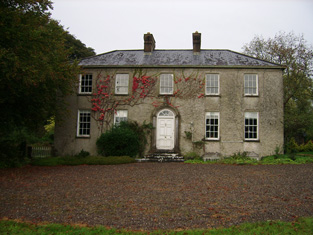
|
| Ballyellis | A home of a branch of the Norcott family in the 18th century. William Wrixon is given as the proprietor of Ballyellis, Mallow, in 1814. In 1837 Lewis refers to Bally Ellis as "formerly the residence of Lord Ennismore and now of A. G. Creagh". By the time of Griffith's Valuation Kilner Brazier held the property in fee. The buildings were valued at £60. Sold to Mr McCormick circa late 1870s and then to Nigel Baring of Baring's Bank in the 1890s. Baring was Master of the Duhallow Foxhounds for a time and changed the name of the house to Avondhu. Later bought by the De La Salle Order of Brothers. Sold by them in 1974 and demolished. | |
| Ballyenahan | A house on the Hyde estate inhabited by the Welsh, Kearney, Spratt, Greene and Barry families in the late 18th and 19th centuries. Wilson, writing in 1786, refers to it as the seat of Mr. Walsh. Eliza Greene was the occupant at the time of Griffith's Valuation when the buildings were valued at £18. The Barrys owned this house until the late 20th century. |
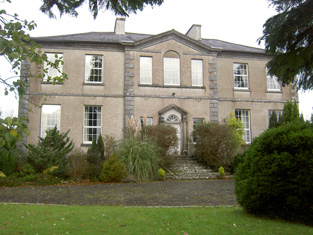
|
| Ballyforan | In 1786 Wilson refers to a house at Ballyforan, the seat of Mr. Kelly. This may be the unamed property shown on the 1st edition Ordnance Survey map, close to the river Suck, which is labelled The Lodge on the subsequent 25-inch edition. At the time of Griffith's Valuation, this property was held from the Greene estate by Thomas Kenny. The house was valued at almost £7 and the nearby mills at £23. It is now a ruin. | |
| Ballyfowloo House | At the time of Griffith's Valuation, James Heaney was leasing a holding of 130 acres from Lord Stanley's estate at Ballyfowloo. The 25-inch Ordnance Survey map of the later 19th century shows a house in this area labelled Ballyfowloo House. |

